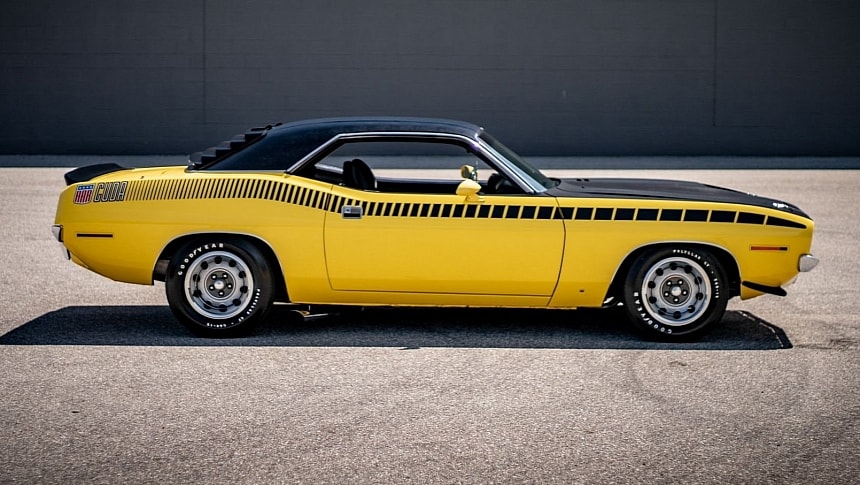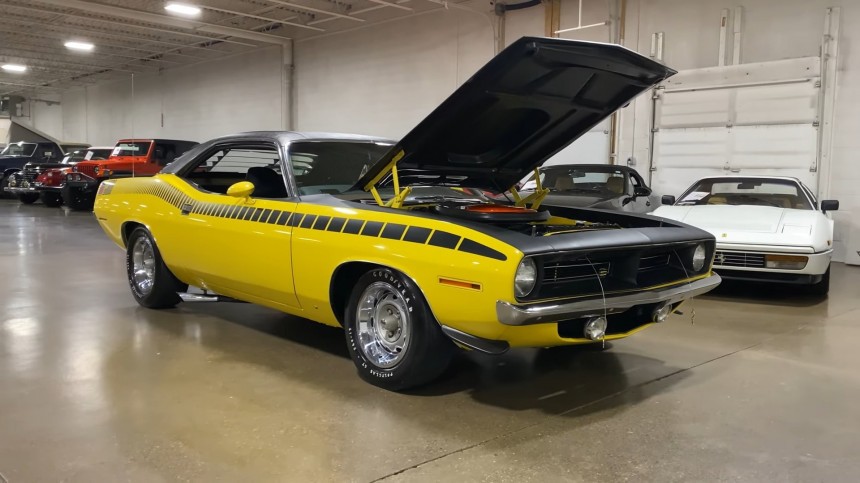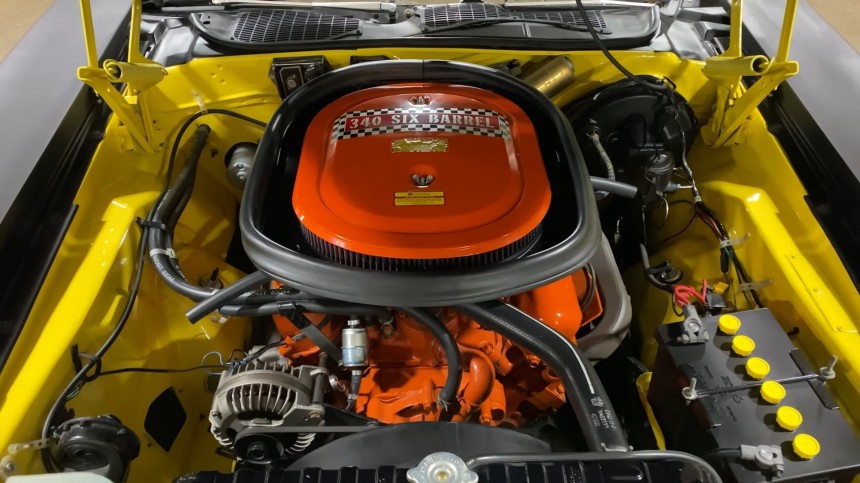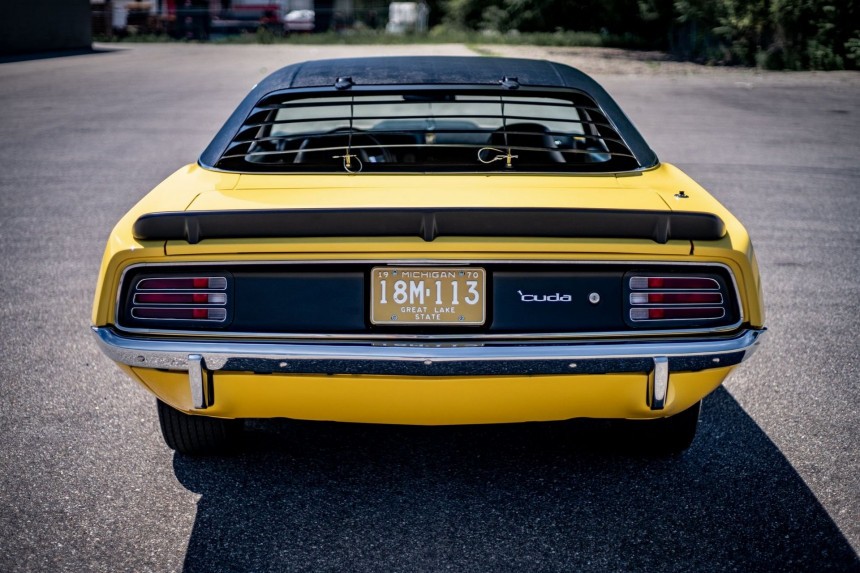Plymouth started the pony car fashion, but it completely surrendered the spotlights to the Ford Mustang just two weeks after the Barracuda debuted on April 1, 1964. It took a long five-and-a-half years before the nameplate countered the Mustang’s dominance. In 1969, the all-new Barracuda was released as a 1970 model year.
The change in styling wasn’t just for beauty’s sake – the Mopar was rebuilt from the ground up on a new platform dedicated to the Barracuda and its Dodge twin, the Challenger. The E-bodies were specifically engineered to accommodate all Chrysler engines, from the 198-cube ‘angled banger’ slant six to the 426 Hemi.
It was about as close to muscle car exaggeration as it could get (although, technically, the Barracuda didn’t entirely fit the bill for ‘muscle car’), and 1970 was a turning point for the nameplate. It was also a two-bladed sword that made a legend, but it claimed it back almost instantly.
The late sixties witnessed fierce attrition wars between GM and FoMoCo for Trans Am supremacy, with the Camaro Z/28 and the Boss 302 as the main stars. (AMC’s venture with the Donohue Javelin is a notable feat, but the small independent manufacturer didn’t have the allure of ChryCo).
Mother Mopar responded with a one-two punch in 1970, releasing the Dodge Challenger T/A (the smart Alecs from Pontiac already registered the Trans Am moniker) and the AAR ‘Cuda. Since the racing rules required a minimal street-legal production of 2,500 units, Dodge and Plymouth rolled their sleeves and started rolling off their one-year-only racers’ duplicates.
The Plymouth’s assembly plants finished the job in a five-week interval, between March and April 1970, with a roll call of 2,724 examples. By contrast, Dodge fell short of the mandatory production landmark, with 2,399 cars. Still, the Plymouth is not commonplace, given that the AAR version of the ‘Cuda was built only in 1970.
It’s not as rare as its Hemi-powered sibling. Still, the 426-equipped ‘Cudas were manufactured for the 1970 and 1971 model years, and the single-year production of the AAR makes it one of the most desired iterations of the Barracuda family. Selling values for these 1970-exclusive gems vary greatly. In the past year alone, we’ve seen examples changing hands for sums ranging between $77,000 and almost $310,000.
It all depends upon a series of critical factors, such as originality, condition, history, optional equipment, rarity, and so on. However, a numbers-matching unit is generally credited with six figures (with the first not necessarily being a ‘1’). However, most of them roam in the 100k-200k range, and the following example falls smack-dab in the middle of that tolerance.
It’s an AAR ‘Cuda, alright, and the selling price is $144,900 – but the bid still has a long way to go, with the highest offer being just $80,000. The car has a replacement 340 cubic-inch V8 that was installed under warranty (we don’t know what happened to the original plant), which was rebuilt with the four-speed manual transmission and differential housing. The original 3.91 rear gearings (with Sure Grip) have been replaced with a more streetable 3.55.
Among the 2,724 AAR Cuda examples ever built, 1,120 had a four-speed transmission, and 138 cars from the total production were sent north of the border to Canada. This is one of those Canadian exports; the current owner has had it since 2005. It also happens to be a document-clad example, with a three-inch thick binder containing a lot of paperwork that proves its history.
The odometer shows a solid 84,387 original miles (135,808 km), and the six-barrel 340-cubic-inch V8 is burbling like it just rolled off the line. Rated conservatively at 290 hp at 5,000 RPM and 350 lb-ft at 3,200 RPM (294 PS, 475 Nm), the 5.6-liter small block motor was capable of a lot more than that. Dyno test revealed figures around 376 horsepower at 5,500 rpm and 409 lb-ft at 4,000 rpm (380 PS, 555 Nm) - a lot of punch for the money.
Speaking of money, this example was bought new in 1970 for $4,178.90 (the base price for a 1970 Plymouth AAR ‘Cuda was $3,966). Adjusted for the inflation rate for the past 54 years, the price would equate to $33,826.36 today. The selling dealership asks almost five times as much, and even so, it’s getting close to the high-priced examples of recent years.
Apart from the mechanical overhauling, this splendid Lemon Twist example had the radiator re-cored, the original triple two-barrel carburetors rebuilt, and the Rallye dash fully restored. The renovators preferred to use New Old Stock as much as possible, and whatever could be reconditioned from the original equipment was reused.
The seats, headliner, hood, hood pins, air cleaner, spare tire, and vinyl top were installed on the Hamtramck assembly line. The seller underlines the rear window trim, color-keyed to the vinyl top instead of stainless steel. The grille is original but has received a $2,000 paint job in its original hue.
It was about as close to muscle car exaggeration as it could get (although, technically, the Barracuda didn’t entirely fit the bill for ‘muscle car’), and 1970 was a turning point for the nameplate. It was also a two-bladed sword that made a legend, but it claimed it back almost instantly.
The late sixties witnessed fierce attrition wars between GM and FoMoCo for Trans Am supremacy, with the Camaro Z/28 and the Boss 302 as the main stars. (AMC’s venture with the Donohue Javelin is a notable feat, but the small independent manufacturer didn’t have the allure of ChryCo).
Mother Mopar responded with a one-two punch in 1970, releasing the Dodge Challenger T/A (the smart Alecs from Pontiac already registered the Trans Am moniker) and the AAR ‘Cuda. Since the racing rules required a minimal street-legal production of 2,500 units, Dodge and Plymouth rolled their sleeves and started rolling off their one-year-only racers’ duplicates.
It’s not as rare as its Hemi-powered sibling. Still, the 426-equipped ‘Cudas were manufactured for the 1970 and 1971 model years, and the single-year production of the AAR makes it one of the most desired iterations of the Barracuda family. Selling values for these 1970-exclusive gems vary greatly. In the past year alone, we’ve seen examples changing hands for sums ranging between $77,000 and almost $310,000.
It all depends upon a series of critical factors, such as originality, condition, history, optional equipment, rarity, and so on. However, a numbers-matching unit is generally credited with six figures (with the first not necessarily being a ‘1’). However, most of them roam in the 100k-200k range, and the following example falls smack-dab in the middle of that tolerance.
Among the 2,724 AAR Cuda examples ever built, 1,120 had a four-speed transmission, and 138 cars from the total production were sent north of the border to Canada. This is one of those Canadian exports; the current owner has had it since 2005. It also happens to be a document-clad example, with a three-inch thick binder containing a lot of paperwork that proves its history.
The odometer shows a solid 84,387 original miles (135,808 km), and the six-barrel 340-cubic-inch V8 is burbling like it just rolled off the line. Rated conservatively at 290 hp at 5,000 RPM and 350 lb-ft at 3,200 RPM (294 PS, 475 Nm), the 5.6-liter small block motor was capable of a lot more than that. Dyno test revealed figures around 376 horsepower at 5,500 rpm and 409 lb-ft at 4,000 rpm (380 PS, 555 Nm) - a lot of punch for the money.
Apart from the mechanical overhauling, this splendid Lemon Twist example had the radiator re-cored, the original triple two-barrel carburetors rebuilt, and the Rallye dash fully restored. The renovators preferred to use New Old Stock as much as possible, and whatever could be reconditioned from the original equipment was reused.
The seats, headliner, hood, hood pins, air cleaner, spare tire, and vinyl top were installed on the Hamtramck assembly line. The seller underlines the rear window trim, color-keyed to the vinyl top instead of stainless steel. The grille is original but has received a $2,000 paint job in its original hue.

























